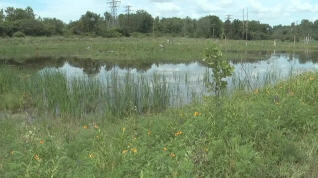ESF, Onondaga Lake Conservation Corps Launch Bioblitz at Onondaga Lake

SUNY-ESF Onondaga Lake bioblitz/SUNY College of Environmental Science and Forestry
Hundreds of scientists, students and members of the public will gather along the shores of Onondaga Lake Sept. 12 and 13 to inventory and identify every species of plant and animal that can be found in 24 hours.
Led by faculty members at the SUNY College of Environmental Science and Forestry (ESF) with support from the Onondaga Lake Conservation Corps, the extensive survey, called a bioblitz, will provide a snapshot of the species — mammals, amphibians, reptiles, birds, fish, insects, fungi, trees, shrubs and other plants — present during that period. Scientists say that snapshot will help them learn more about how to continue restoring this important landscape.
“It’s important for the public to know what a gem Onondaga Lake is, along with the surrounding landscape,” said Dr. Donald Leopold, an ESF Distinguished Teaching Professor who chairs the ESF Department of Environmental and Forest Biology. “This has been one of the most exciting remediation projects in the United States.”
The bioblitz is part of the celebration surrounding the inauguration of ESF’s fourth president, Dr. Quentin Wheeler. Wheeler will be formally installed during a ceremony at 10 a.m. Friday, Sept. 12. The bioblitz begins later that afternoon and continues around the clock. Results will be reported during a reception on the ESF campus at 4 p.m. Sept. 13.
Wheeler, an entomologist with an interest in species exploration and biodiversity, said the cultural and scientific significance of Onondaga Lake makes it an appropriate place for a bioblitz.
“Onondaga Lake is the birthplace of the Haudenosaunee Confederacy,” Wheeler said. “In the early 20th century, it was a resort and a major tourist attraction. In the last several years, Onondaga Lake has undergone perhaps the most significant restoration effort of any lake in the country. Its recovery is an example of how an ecosystem can recover from degradation. Learning more about its current state will help us better chart its future.”
Leopold and his colleagues have worked at the lake for more than 12 years. His focus is using native plants to restore ecosystems so they are both functional and aesthetically pleasing.
“Onondaga Lake and the surrounding area is one of the most interesting landscapes in upstate New York,” Leopold said. “There are inland salt marshes and fens, and there used to be significant chestnut forests. Given some of the exciting things we are seeing lately, it’s time to take that snapshot.”
Leopold said a number of features combine to make the Onondaga Lake ecosystem unique. During the winter, it hosts the largest urban population of eagles in the United States. It is the site of rare inland salt marshes that are tied to the economic history of Syracuse; these salt marshes can be restored and expanded using the root and seed stock that is already present. In another 25 years, he said, that restoration potential could be lost if the marsh area continues to shrink. The ecosystem also includes fens that provide habitat for rare plants and was once the site of a significant grove of American chestnut trees that was wiped out by the blight that killed most of the species in the eastern United States.
The bioblitz could involve hundreds of participants. It will draw heavily from the faculty, staff and students at ESF and from volunteers who have become environmental stewards through the Onondaga Lake Conservation Corps. The Corps, established in 2012, is a growing organization of community volunteers who contribute to restoration projects that create or improve wildlife habitat in the Onondaga Lake watershed. Founding partners of the Corps include Montezuma Audubon Center, Onondaga Audubon Society, Parsons, O’Brien & Gere and Honeywell.
Members of the public will be able to participate in and follow the bioblitz via social media. Members of the public will be able to participate in and follow the bioblitz via social media. Anyone wishing to follow bioblitz news as it happens can do so via Twitter, #ESFbioblitz. Official tweets will be via @SUNYESFalumni.
Contact Information
Claire Dunn
cbdunn@esf.edu
Phone: 315-470-6650
or
Dave White
dewhite@esf.edu
315-470-6645
Media Contact
More Information:
http://www.newswise.com/articles/view/622729/?sc=dwhr&xy=5048111All latest news from the category: Ecology, The Environment and Conservation
This complex theme deals primarily with interactions between organisms and the environmental factors that impact them, but to a greater extent between individual inanimate environmental factors.
innovations-report offers informative reports and articles on topics such as climate protection, landscape conservation, ecological systems, wildlife and nature parks and ecosystem efficiency and balance.
Newest articles

Nerve cells of blind mice retain their visual function
Nerve cells in the retina were analysed at TU Wien (Vienna) using microelectrodes. They show astonishingly stable behavior – good news for retina implants. The retina is often referred to…

State-wide center for quantum science
Karlsruhe Institute of Technology joins IQST as a new partner. The mission of IQST is to further our understanding of nature and develop innovative technologies based on quantum science by…

Newly designed nanomaterial shows promise as antimicrobial agent
Rice scientists develop nanocrystals that kill bacteria under visible light. Newly developed halide perovskite nanocrystals (HPNCs) show potential as antimicrobial agents that are stable, effective and easy to produce. After…



